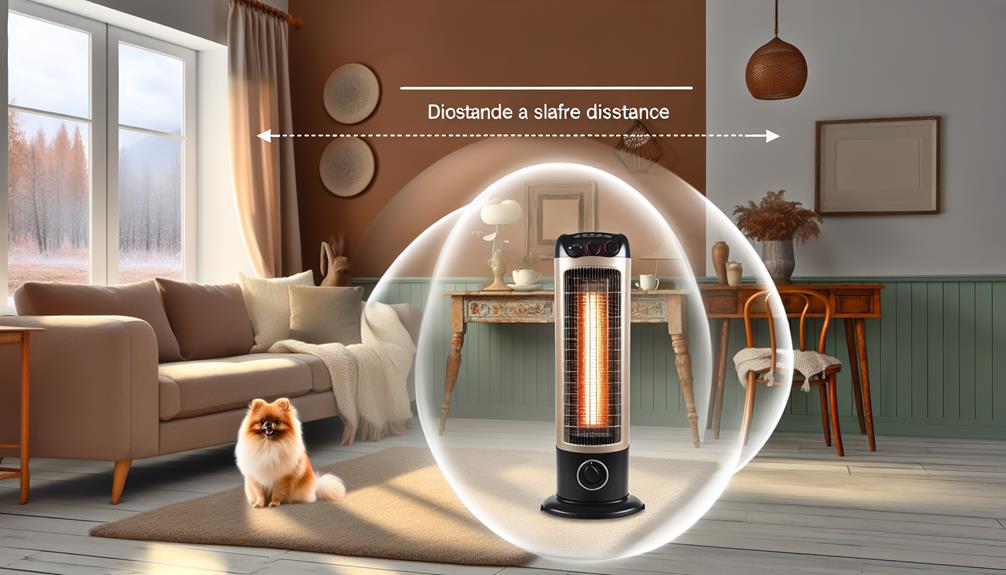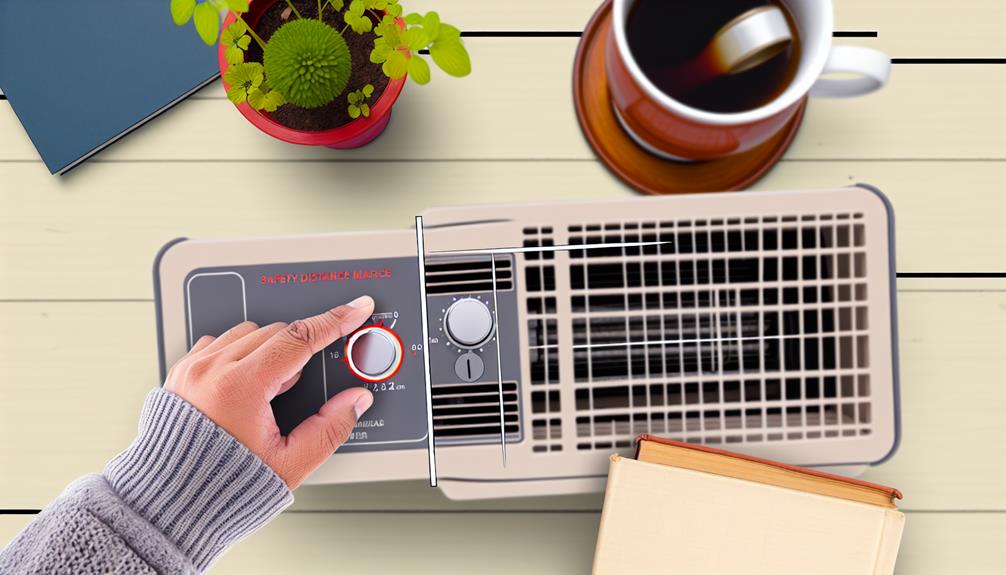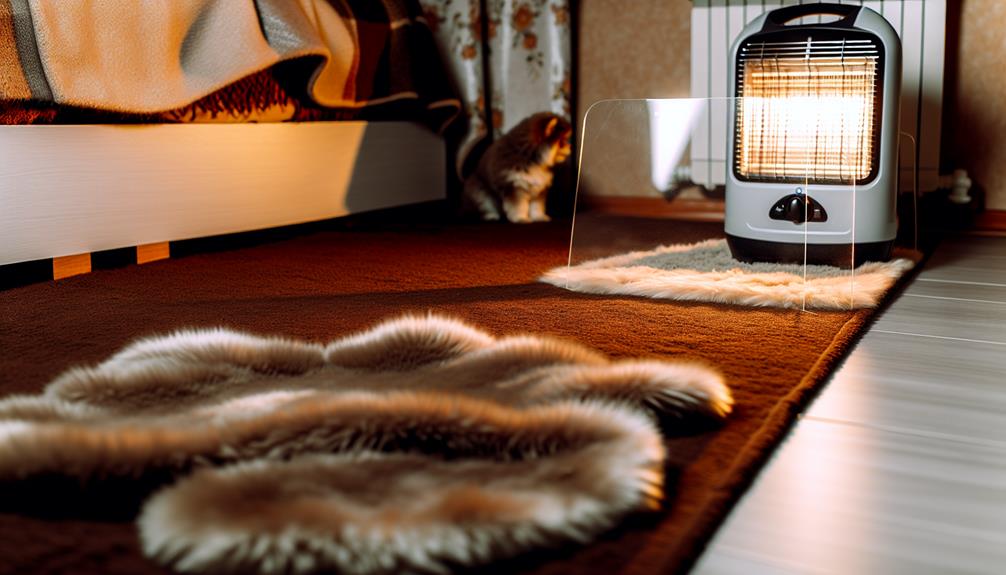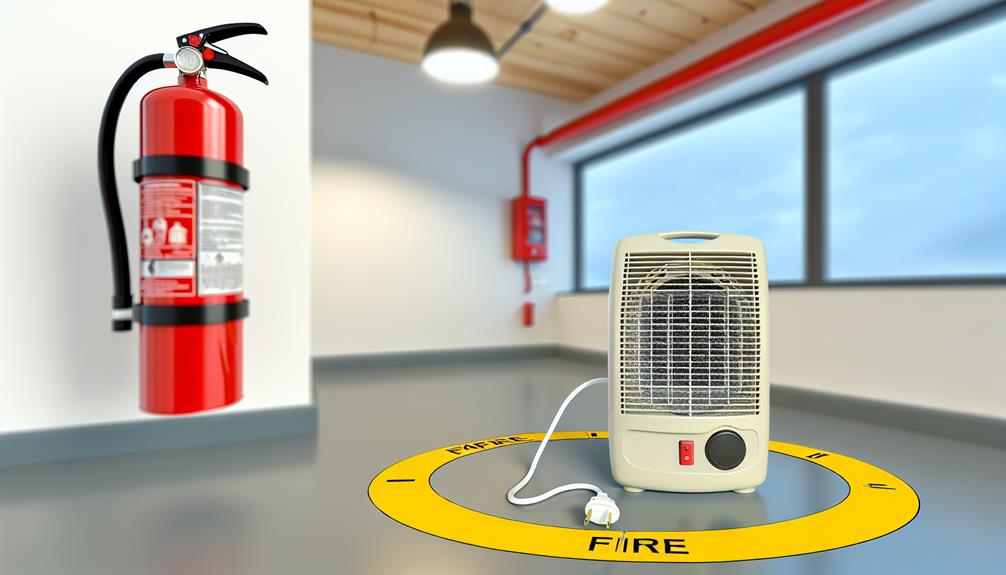According to the National Fire Protection Association, heating equipment is the second-leading cause of home fires in the United States. As you rely on your portable heater to keep you warm during the chillier months, it's imperative that you're aware of the critical safety measures that should be in place to protect you, your family, and your home. Whether you're using an electric space heater, a kerosene heater, or any other portable heating device, there are essential guidelines and best practices you ought to follow. Proper understanding of your heater's operation, the significance of regular maintenance, and how to recognize potential hazards can mean the difference between cozy comfort and a dangerous situation. What you may not know are the subtle yet vital steps you need to take to ensure your safety, and perhaps you're unaware of the common misconceptions that could put you at risk. Let's explore these aspects together, ensuring your warmth doesn't come with unwelcome consequences.
Key Takeaways
- Understand the different types of portable heaters and their specific features, such as convection, radiant, oil-filled, micathermic, and fan-forced heaters.
- Prioritize safety features like overload protection, tip-over switch, automatic shut-off, and cool-touch exterior when choosing a portable heater.
- Proper placement and spacing are essential to prevent overheating and potential ignition, so keep at least 3 feet of space between the heater and combustible materials.
- Select a solid, heat-resistant surface for the heater, maintain ample spacing for proper air circulation, and avoid using heaters in enclosed spaces without proper ventilation.
Understanding Portable Heater Types

Navigating the diverse landscape of portable heaters requires understanding the various types available, each with its distinct mechanisms and applications. You'll want to consider heating efficiency and energy consumption when selecting a unit that best aligns with your needs.
Convection heaters, for instance, work by circulating warm air through a room, using either liquid or a ceramic element to generate heat. They offer a steady, even distribution of warmth, making them ideal for consistent heating in enclosed spaces. These models typically exhibit high heating efficiency, as they maintain temperature effectively over time, reducing the need to cycle on and off frequently, which can save on energy consumption.
Radiant heaters, on the other hand, deliver immediate warmth, targeting objects and people directly in their path through infrared rays. They're highly efficient in smaller areas or for personal use, as they heat objects rather than air. This direct approach minimizes energy consumption by concentrating heat where it's needed most.
Then there's the oil-filled radiator, a type of convection heater known for its energy efficiency. It retains heat well, allowing the device to power down while the room stays warm, leading to less energy used overall. However, it may take longer to heat up a space initially.
Micathermic heaters are a hybrid, emitting both convection and radiant heat. They provide quick warmth and are typically lightweight and silent. Their dual heating method means they can heat a room uniformly like a convection heater while offering the spot heating benefits of a radiant model.
Finally, fan-forced heaters blow air over a heated element, quickly warming a space. While effective, they may not be as energy-efficient as other types due to the continuous operation of the fan.
Your choice should balance personal comfort, heating efficiency, and energy consumption to ensure safety and cost-effectiveness.
Essential Safety Features
While selecting a heater that suits your comfort and efficiency needs is crucial, it's equally important to prioritize models equipped with advanced safety features to mitigate risks. As you're browsing for your ideal portable heater, keep an eye out for these non-negotiable safety characteristics:
- Overload Protection: This feature prevents the heater's circuit from overheating by automatically shutting off the power if an electrical overload is detected. Overload protection is indispensable, as it not only safeguards the heater from damage but also minimizes the risk of fire hazards.
- Tip-Over Switch: Accidents happen, and a heater could get knocked over. A tip-over switch ensures that if your heater does tip, it will immediately turn off, preventing any potential fire risk. This feature is particularly crucial if you have pets or young children.
- Automatic Shut-Off: Heaters with this function will turn off automatically after a set period or when they reach a certain temperature. This helps avoid overheating and the associated dangers, providing you with peace of mind, especially if you tend to forget to turn off appliances.
- Cool-Touch Exterior: To prevent burns upon contact, many heaters are designed with exteriors that remain cool to the touch, even when the unit is in use. This feature is especially important in homes with curious kids or when the heater is within easy reach.
Proper Placement and Spacing

You must always maintain a safe distance between your portable heater and any flammable objects to prevent fire hazards. Ensure the heater is placed on a solid, flat surface to avoid tipping and potential fires. Additionally, refrain from using heaters in enclosed spaces where ventilation is poor, as this can lead to dangerous carbon monoxide build-up.
Safe Distance From Objects
Maintaining a safe distance between your portable heater and nearby objects is essential to prevent fire hazards and ensure efficient operation. Combustible proximity can lead to dangerous situations, while proper furniture clearance is crucial for safety. Consider these guidelines:
- Keep at least 3 feet of space between the heater and any combustible materials, such as curtains, bedding, or clothing.
- Furniture should be at least 3 feet away to prevent overheating and potential ignition.
- Place the heater on a level, non-flammable surface to minimize the risk of it tipping over.
- Avoid using heaters in crowded areas where objects may be inadvertently placed too close.
Heater on Solid Surfaces
Building on the necessity of keeping heaters away from combustibles, it's equally important to ensure they're placed on solid, stable surfaces to reduce the risk of tipping and overheating. You must select a surface that provides stability to prevent your heater from falling over, which could lead to fires or damage to the unit. Surface stability is not just about preventing accidents; it also ensures that the heater functions efficiently. Moreover, the chosen surface must exhibit heat resistance to withstand the temperatures generated by the heater without deforming or igniting. Always maintain ample spacing around the heater – typically at least three feet – to allow for proper air circulation and to avoid blocking the heater's vents, which can lead to overheating or a potential fire hazard.
Avoid Enclosed Spaces
Although it may seem convenient to place a portable heater in a cozy corner or small space, it's crucial to avoid enclosed areas to ensure proper ventilation and reduce the risk of fire hazards. When using a portable heater, consider the following points to minimize risks:
- Maintain a Safe Distance: Keep the heater at least 3 feet away from combustible materials.
- Ensure Adequate Ventilation: Prevent carbon monoxide risks by allowing fresh air to circulate.
- Avoid Small, Unventilated Rooms: Small spaces can lead to oxygen depletion and increased fire risk.
- Heed Manufacturer Guidelines: Always follow the specific safety instructions provided for your heater model.
Operating Instructions and Precautions

When operating a portable heater, it's crucial to follow the manufacturer's guidelines to ensure your safety and the device's proper functioning. Before you even plug in your heater, familiarize yourself with the type of fuel it uses, whether it's electricity, propane, kerosene, or natural gas. Improper fuel use can lead to dangerous malfunctions or inefficiency. Additionally, be mindful of thermostat settings; setting the temperature appropriately will not only keep you comfortable but also prevent the unit from overheating.
Always inspect the heater before use. Check for any damage to the cord or plug, and ensure that the heater is on a stable, level surface, away from foot traffic and combustible materials. Turn the heater on using the controls as described in the user manual, and make sure the safety features, such as overheat protection or tip-over switches, are functioning correctly.
Never leave a portable heater unattended while in use, especially when children or pets are present. It's tempting to leave a heater on for long periods for continuous warmth, but doing so without supervision increases the risk of a fire. If you must step away, even briefly, turn the heater off. When you're finished using the heater, don't just unplug it; follow the manufacturer's instructions for shutting it down properly. Allow the heater to cool down before storing it, and never store it with the fuel inside if it's not in use.
Regular Maintenance and Cleaning
To ensure your portable heater operates safely and efficiently, you'll need to establish regular inspection and care routines. It's crucial to keep the unit free from dust and debris, which can obstruct airflow and pose a fire hazard. Adhering to a maintenance schedule not only prolongs the life of your heater but also safeguards your home against potential risks.
Inspection and Care Routines
How often do you check your portable heater for signs of wear or damage? Routine checks are essential for ensuring safety and longevity. Here's what you need to do:
- Inspect Cords and Plugs: Before each use, examine for frayed wires or loose connections.
- Check for Dust and Debris: Regularly clean air intakes and grilles to prevent overheating.
- Look for External Damage: Dents or cracks could indicate internal problems.
- Careful Storage: When not in use, store your heater in a dry, dust-free environment to avoid corrosion and clogging.
Dust and Debris Removal
Removing dust and debris from your portable heater is a critical maintenance step that ensures efficient operation and prevents potential fire hazards. Over time, these unwanted particles can accumulate, obstructing airflow and compromising your heater's performance. Regular cleaning is essential, not just for safety but also for maintaining the unit's longevity and effectiveness.
| Maintenance Task | Frequency | Benefit |
|---|---|---|
| Filter Replacement | As recommended | Airflow optimization |
| Dusting External Vents | Monthly | Prevents blockages |
| Vacuuming Internal Fans | Seasonally | Maintains efficiency |
| Checking for Debris | Before each use | Reduces fire risk |
Always refer to your heater's manual for specific guidance on filter replacement and cleaning protocols. By adhering to these practices, you'll ensure that your portable heater operates at peak efficiency and remains a safe addition to your home.
Recognizing and Addressing Hazards

Recognizing the hazards associated with portable heaters is the first step in ensuring your home's safety. Adequate cord management and understanding ventilation requirements are critical. Portable heaters can pose serious risks if not used correctly. So, let's dive into the specifics:
- Cord Management: Heaters often come with lengthy cords that can easily become a tripping hazard or overheat if covered by rugs or furniture. Ensure cords are secured and routed away from high-traffic areas. Additionally, avoid using extension cords or power strips, which can cause overheating and potentially start a fire.
- Ventilation Requirements: Fuel-burning portable heaters produce carbon monoxide, a deadly, odorless gas. To prevent accumulation, these heaters must be used in well-ventilated areas. Always follow the manufacturer's instructions regarding ventilation.
- Proximity to Combustibles: Keep your heater at least three feet away from anything that can burn—curtains, furniture, bedding, and clothing. This clear zone minimizes the risk of accidental fires.
- Stable Positioning: Place your heater on a stable, level surface where it won't be knocked over. Some models come with a safety switch that automatically turns off the device if it tips over; consider this feature when purchasing a new heater.
It's crucial to recognize these risks and address them proactively. Regularly inspect your heater for any signs of damage or wear, particularly the power cord and plug. Never leave a portable heater unattended, and always turn it off before leaving the room or going to bed. Remember, safety is not just about the device but also how you use it. Stay informed, stay vigilant, and you'll stay warm and safe throughout the colder months.
Child and Pet Safety Considerations
When considering the safety of children and pets, it's essential to be mindful of the additional risks that portable heaters can pose in a household environment. Your vigilance should extend beyond the basic operation of the device to include proactive measures that ensure the well-being of your little ones and furry friends.
Firstly, it's advisable to opt for heaters equipped with childproof locks. These locks prevent curious hands from altering the settings or opening parts of the heater that could lead to burns or electric shocks. Always engage these locks when the heater is within reach of children.
Additionally, establish a clear perimeter around the heater. Pet proof barriers, such as safety gates, can be used to create a safe distance between the heater and your pets. This prevents them from getting too close and potentially getting burned or knocking the heater over, which could cause a fire.
It's also important to keep portable heaters out of high traffic areas where children play or pets may run. Position them in a location where they are less likely to be bumped into or toppled over. Always supervise the use of the heater when young children and pets are present, and never leave it on unattended.
Educate older children about the dangers associated with portable heaters and instruct them to maintain a safe distance. For pets, training can be helpful to teach them to avoid the heater. Remember, the combination of curiosity and a hot surface can be hazardous.
Emergency Procedures and Tips

Emergency Procedures and Tips
In the event of a portable heater-related emergency, it's crucial to act swiftly and follow a well-rehearsed plan to minimize risk and damage. Understanding the steps you need to take can be the difference between a controlled situation and a catastrophic one. Here are the key actions you should commit to memory:
- Cut the Power: Disconnect the heater immediately. If it's not safe to approach, switch off the power at the circuit breaker.
- Extinguish the Fire: If a small fire has started, use a fire extinguisher—only if you're trained and it's safe to do so. Aim at the base of the fire, not the flames.
- Evacuate Immediately: If the fire escalates, don't attempt to fight it. Head to the nearest fire exit, keeping low if there's smoke.
- Alert Emergency Services: Once you're in a safe location, call 911 or your local emergency number. Provide clear details about the situation and the location of the fire.
Smoke alarms are your first line of defense in a fire, so ensure they are installed and working properly in every room where a portable heater is used. Regularly test them and change batteries as necessary. Make sure everyone in your household knows the sound of the alarm and what to do if it goes off.
Plan and practice an escape route, so you and your family know how to reach fire exits quickly and safely. Keep these exits clear at all times, as obstructions can become lethal in an emergency. Always prioritize safety over property; possessions can be replaced, but lives cannot. Stay calm, and don't take unnecessary risks.
Frequently Asked Questions
How Does the Energy Efficiency of Portable Heaters Compare to Central Heating Systems?
When comparing the energy efficiency of portable heaters to central heating systems, you've got to consider heating costs and zoned comfort. Portable heaters can be more efficient for heating small, specific areas, reducing overall heating costs. In contrast, central systems heat the entire home, which can be less efficient if you're only using a few rooms. Always look for energy-efficient models to optimize your energy usage and comfort.
Can I Use an Extension Cord With My Portable Heater, and if So, What Type Should I Use?
You're walking a tightrope with fire beneath when you pair portable heaters with extension cords! Extension safety is no joke. Always check the cord rating—don't just grab any old one from the garage. You need a heavy-duty cord that can handle the heater's power demands without overheating. Remember, it's not just about convenience; it's about your safety. So, use the right cord, or don't use one at all.
Are There Any Health Risks Associated With Using Portable Heaters, Such as Respiratory Issues or Dry Skin?
Absolutely, using portable heaters can pose health risks, like aggravating respiratory issues due to indoor pollution. They can burn dust or other particles, worsening air quality. Also, heaters often lower humidity levels, which might lead to dry skin or irritate your respiratory tract. It's crucial to keep your space ventilated and consider a humidifier to maintain a balanced environment. Always follow the manufacturer's guidelines to minimize any potential health hazards.
Can Portable Heaters Interfere With Electronic Devices or Wi-Fi Signals in My Home?
Portable heaters can cause electromagnetic interference, potentially leading to signal disruption of your electronic devices or Wi-Fi. It's rare, but if your gadgets act up, keep them away from the heater. Remember, maintaining a safe distance minimizes risks, ensuring your tech runs smoothly. Always consult the heater's manual for specific guidance on placement and operation to prevent any hiccups in your home's electronic ecosystem.
How Does Altitude Affect the Performance of a Portable Heater?
At high altitudes, you'll find your portable heater may not perform as efficiently. The thinner air presents high elevation challenges, which can reduce the oxygen available for combustion in gas heaters, leading to incomplete burning and potentially dangerous carbon monoxide levels. Oxygen depletion risks are real; it's crucial to ensure adequate ventilation and consider altitude-rated heaters to maintain safety and optimal functioning in your mountain cabin or elevated home.
